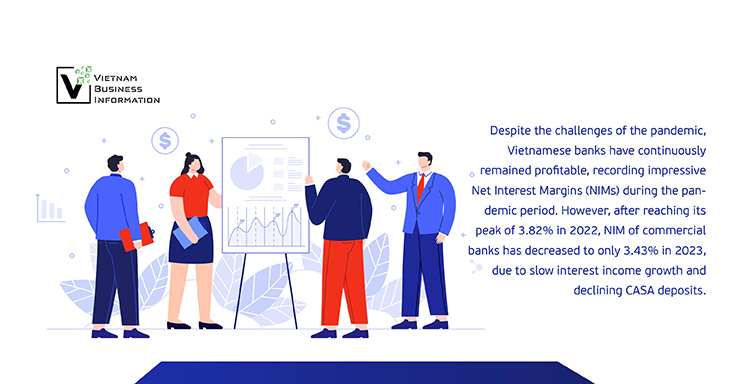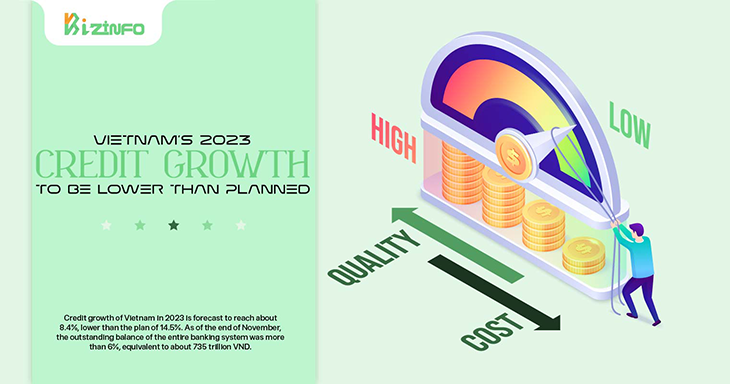Published May 2024
Contrasting growth among banking groups
Large private commercial banks have consistently led in growth but face increasing bad debts, especially related to real estate. Conversely, state-owned commercial banks adopt a more cautious stance due to concerns about deteriorating credit quality of borrowers.

Differences in credit efficiency
Last year, Vietnam witnessed a significant decline in credit growth due to a slowdown in labor-intensive sectors. Credit easing remained sluggish throughout the first 11 months of 2023 before witnessing a sudden surge in December (about 4.2%), primarily from the real estate and construction sectors.
Recent data shows differences in credit efficiency among banking groups, with large joint-stock commercial banks such as MB, Techcombank, leading in growth. On the other hand, state-owned commercial banks (SOCBs) adopt a more cautious approach due to concerns about declining credit quality of borrowers.

In reality, many commercial banks still face increasing non-performing loans (NPLs) as borrowers' repayment abilities decline due to economic difficulties, primarily related to real estate loans.
It is reported that the NPL ratio remains high and hasn't peaked yet, making the coverage ability of bad debts increasingly serious, necessitating an urgent extension of Circular 02.
Increased loan risk provisioning due to bad debts along with declining Net Interest Margin (NIM) has slowed down banks' net profit growth, reaching only 3.6% compared to the same period in 2022.
State-owned commercial banks recorded positive profit growth thanks to healthy loan portfolios with lower risk provisions. Vietcombank, BIDV, and Vietinbank were ranked among the top 10 banks in terms of after-tax profits in 2023.
Conversely, third-tier joint-stock banks experienced a significant decline in profits, down by 66% compared to the same period. Despite higher credit growth, these banks face heavier provisioning burdens and lower non-interest income, primarily from bancassurance.
Regarding Capital Adequacy Ratio (CAR), while this ratio decreased in most banks in the region from 2022 to June 2023 due to a decrease in asset quality, Vietnamese banks still maintain CAR above the minimum requirement of Basel II.
Large and medium-sized joint-stock commercial banks actively increase CAR to address economic challenges and ensure sufficient reserves for lending.
On the contrary, state-owned commercial banks have lower CAR, with Vietinbank and BIDV having the lowest ratios in the banking sector, both at 8.9%. However, state-owned commercial banks are expected to improve as some banks have made efforts to increase their charter capital throughout 2023.
Significant income fluctuations
Despite contrasting operational results, the entire banking industry has experienced significant income fluctuations in both credit and non-credit segments.
In fact, nearly 80% of bank income still relies on credit, thus, along with the slow credit growth trend, total operating income of banks grew modestly at only about 4% in 2023.
Non-interest income, especially service fee income, has been severely affected by unfavorable developments in the insurance market, leading to a decrease in bancassurance revenue for many banks.
Due to the impact of "scandals" in insurance consultancy and new regulations of the 2024 Law on Financial Institutions, it is predicted that income from these activities is expected to continue to decrease, prompting banks to reassess their fee collection strategies.
Conversely, funding costs are trending downward and are considered a key factor supporting banks' interest spread recovery after a challenging year.
Despite the challenges of the pandemic, Vietnamese banks have continuously remained profitable, recording impressive Net Interest Margins (NIMs) during the pandemic period. However, after reaching its peak of 3.82% in 2022, NIM of commercial banks has decreased to only 3.43% in 2023, due to slow interest income growth and declining CASA deposits.

For the recovery prospects in 2024, it is forecast that banks will benefit from expanded monetary policies, credit demand recovery, and debt relief measures.
Thus, credit growth is expected to improve in the second half of 2024 due to increased credit demand from manufacturing, export sectors, and domestic consumption.
Furthermore, the SBV's decision to set a one-time credit growth limit for commercial banks at 15-16% from early 2024 will create conditions for banks to proactively push forward disbursement plans.
State policies such as the extension of Circular 02 for debt rescheduling until the end of 2024, SBV's expansionary monetary policy keeping interest rates low, will boost credit demand and improve net interest margins in 2024 due to reduced capital costs.
However, the deterioration in asset quality across the entire system still raises concerns for the banking industry as the NPL ratio remains high and shows no signs of peaking. With slow asset quality recovery, banks will continue to face increasing pressures, which may negatively impact profits.
Additionally, policy risks may change in the second half of the year due to inflationary pressures, potentially increasing capital costs and affecting banks' net interest margins by the end of 2024-2025.
Moreover, net income from service fees and commissions may face challenges, mainly due to issues related to insurance activities after the new Law on Financial Institutions was enacted in July 2024.
Source: theleader
Compiled by VBI















